Jimi Hendrix. The Who. Janis Joplin. Simon & Garfunkel. The Rolling Stones. The Monkees. Spinal Tap. Beastie Boys. Despite the Criterion Collection’s primary reputation as a depository for the work of cinema’s greatest directors and screen performers, these pivotal musical artists have also earned their rightful place in the world’s greatest line of films-on-disc. Expand the boundaries a bit and you can add Miles Davis, Brian Eno, the Sex Pistols and even Wolfgang Amadeus Mozart, among others, to this immortal lineup, not to mention all the amazing talent to be found among the composers who wrote original soundtrack music for so many films. Now, as of last week, one more headliner took their place in this pantheon: The Leningrad Cowboys, indisputably the greatest performing act to ever emerge from the frost-hardened sub-Arctic soil of Finland.
The release of Eclipse Series 29: Aki Kaurismäki’s Leningrad Cowboys is at once a sensible addition as well as a refreshing change of pace for Criterion’s line of bare bones box sets. It’s the second entry that Kaurismäki has secured in the series, after his breakthrough films of the mid-1980s collected as the Proletariat Trilogy. That puts him alongside venerable auteurs like Akira Kurosawa (that “other” A.K.) and Yasujiro Ozu as the only directors to warrant that distinction of multiple Eclipse releases. What makes it stand out from the 28 sets preceding it is the sheer pop culture sensibility of the package, that includes not just two feature length films but also a third disc with a live concert performance and a collection of short music videos of the sort that used to be MTV’s stock in trade. It has the most contemporary feel of anything issued by the Eclipse line so far, with probably the greatest prior familiarity for today’s audience of all they’ve yet released. The Leningrad Cowboys were never massive stars in the US, at least compared to the fame they generated in Europe, but they did appear on the MTV Video Music Awards in 1994 and their unique look and sound undoubtedly stuck in the memories of viewers even if they weren’t inexorably drawn in to become dedicated fans.
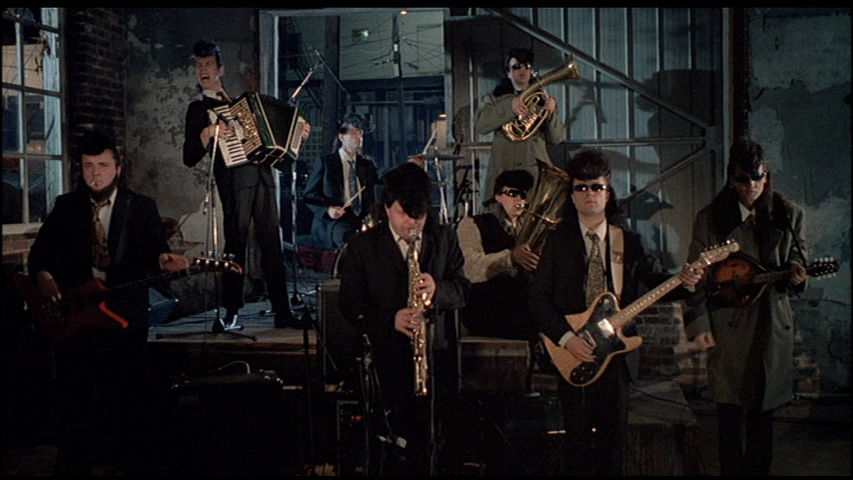
Whatever one’s past take on the Cowboys may have been though, this nice new package serves as a strong re-introduction to a group that is still putting out new product. Just this past Friday, the Leningrad Cowboys unveiled a new album, Buena Vodka Social Club. I haven’t bought my copy yet, but couple that with the DVD release and I have to figure that the Finnish economy is getting a nice little boost, regardless of whatever other fiscal havoc is churning up the Eurozone. And more power to ’em. Though I’d seen and heard the Cowboys do their thing on TV in the past and granted them a chuckle or two at the sheer absurdity of their presentation, this past week spent delving into their music and mythos has left a more indelible impression and made me appreciate the intelligent creativity that went into what looks on first impression like a goofy novelty act.

For the purposes of this review, I’m going to break one of the rules I set for this column, in that I’m going to write up the entire set and leave it at that, rather than dedicate one post per film like I usually do. My reasoning is that these works are really all of one piece, despite the diverse formats mentioned above and the distinctions that exist between the two main movies, Leningrad Cowboys Go America and Leningrad Cowboys Meet Moses. So let me walk you through the contents that await your discovery, in the chronological order I like to take and always recommend.
The Cowboys’ saga begins with Rocky VI, a 1986 short that only featured an early version of the band on the soundtrack and one of their members as a key performer. The visuals are a cheeky black & white parody of Rocky IV in which Sylvester Stallone epitomized Reagan-era American jingoism by heroically fighting and defeating a viciously chiseled and meticulously bio-engineered specimen of Soviet athletic superiority. In Rocky VI, the tables are turned as Igor, a burly brute with eyebrows so bushy they make Leonid Brezhnev look like a spokesman for Maybelline, basically mops up the floor with the scrawny runt at risk of being swallowed up in his voluminous Stars and Stripes boxing trunks. There’s not much plot or suspense to be found here, just a dismissive pushback from a sympathetic neighbor of the Eastern Bloc to puncture Stallone’s gasbag portrayal of USA triumphalism over the cruel commie minions of the Evil Empire. The music is vintage 80s synth-pop, not at all the tuba-informed folk-rock that the Cowboys eventually came to be known for.
Next comes Through The Wire, another black & white genre parody, this time film noir with a jailbreak twist. The music is bluesy and sax-driven, showing the Cowboys as still a conventional band of its era looking to get airplay from original material than the inspired cover versions that made them famous. The video winks at the standard late-night booze’n’smokes, on the lam in Skid Row tropes so thoroughly explored over the years, but is most notable as the first appearance of the trademark unicorn pompadour hairstyles of the band members. Their look hadn’t quite reached the consistency of a uniform at that point, but was well on its way.
The third short film, L.A. Woman, represents another big step forward in the Cowboys’ evolution. Capturing the band on stage, the music updates the Doors’ original rollicking shuffle with Van Halen-style guitar leads and female backing vocals, while we see the full band tearing it up, looking pretty scruffy in general but reinforcing the signature hairdos & shades. A handful of graphic visual elements are injected to lend touches of Kaurismäki’s political consciousness to an otherwise straightforward performance video.
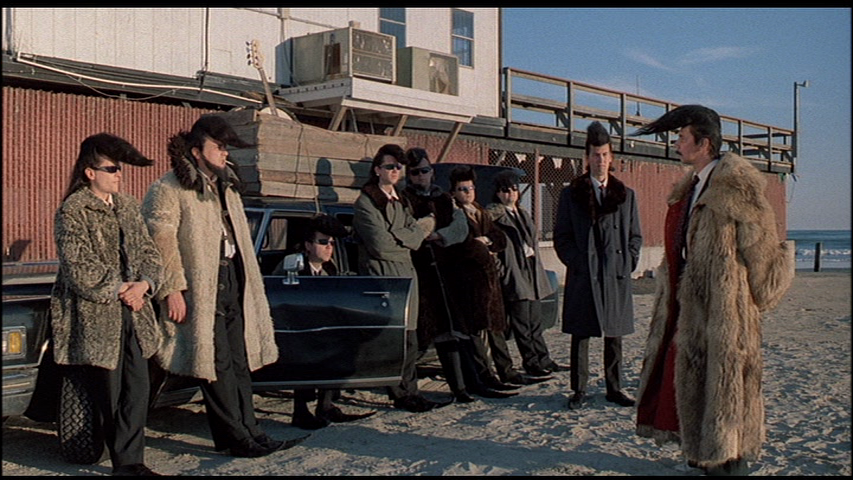
Those shorts all preceded what still stands as the cinematic crown jewel of this set. Leningrad Cowboys Go America is a fun, swift and smartly paced frolic, clocking in at just under 80 minutes and laying the essential foundation for the rest of the Leningrad Cowboys’ career. It provides the fictionalized back story of how the band emigrated from its Siberian village home to the USA in search of money, fame and most of all, sheer relief from the overwhelming boredom that accompanies life on the tundra. Seizing upon the stroke of genius that gave their version of L.A. Woman added punch, in this film the Leningrad Cowboys are a straight-up cover band, usually focused on Western pop hits but quite capable of delivering a jaunty polka on a moment’s notice. The story sets them off on a trek from their first landing in New York City, through the American South visiting celebrated locales like Memphis, New Orleans, Galveston and San Antonio en route to perform at a Mexican wedding. By now, the L.G. trademarks are all in place – they’ve perfected the architectural consistency of their hairstyles, introduced the wickedly pointy shoes and choreographed their on- and off-stage movements with the precision of a well-trained school of fish. It’s a bit of the Blues Brothers, a dash of Devo and a boost of Borat, all rolled up into one tight-knit octet and their conniving, treacherous manager Vladimir. Assuming that one can get on board with the basic premise to begin with, here are the Cowboys at their best. The music is great, the laughs come freely and frequently and the movie doesn’t wear out its welcome. It contains all that is most charming about the Leningrad Cowboys, nicely rounded off by the notoriously patient deadpan humor and fascinating mundane landscapes that Kaurismäki brought to the project. (Leningrad Cowboys Go America was filmed in between Ariel and The Match Factory Girl, the second and third installments of the Proletariat Trilogy, respectively.)
With Leningrad Cowboys Go America proving to be a modest success with the early 90s hipster crowd, it comes as no surprise to find that their next collaborations with Kaurismäki in the short film format built squarely on the feature film’s formula. Cover versions of Those Were The Days (among the most effective inducers of hungover melancholy known to humanity) and These Boots (Nancy Sinatra’s iconic go-go girl strut) evoke fond nostalgia among audiences who grew up listening to those tunes on their parents records, infusing vodka-chugging visual humor with the requisite ironic touches of lyrical recontextualization into the pseudo-Siberian milieu. Of the two, These Boots is the funniest and most memorable, but I love both of the songs and enjoyed the unique takes on these pop standards.

That brings us to the second feature-length film in this set, Leningrad Cowboys Meet Moses. It’s a longer, not quite as funny and somewhat muddled affair in comparison to Go America. I give credit to Kaurismäki and the band for taking a few more risks and not just repeating themselves with a second helping of the familiar rock’n’roll hits that made the first film so easily engaging. Instead, they pick up the action in Mexico, where the Cowboys previously left off, though the band is just a shell of its former self, having lost around half their members through overdoses of tequila or wanton criminality. (This is likely just a pretext for explaining away the real-life turnover of band members in the five years between the two movies, but we’ll play along with it.) With a newfound mariachi flavor added to their repertoire, the survivors are summoned back, rather against their will, to Brooklyn where they’re promised a lucrative gig. It turns out to be a manipulative ploy by their former manager Vladimir, now “born again” as Moses, a quasi-Hebrew zealot who’s found a new cover to disguise his cold-hearted exploitation. From there, the plot meanders back to Russia, relocating the first film’s road trip structure to Europe, involving some odd contrivances about the theft of the Statue of Liberty’s nose (some kind of off the wall tribute to Nikolai Gogol?), a CIA agent nemesis in pursuit of the band and ideological jabbering between proponents of competing biblical vs. Marxist orthodoxies. My hunch is that the humor hits more squarely home with a European audience, where the landmarks and cultural references carry more of the resonance that I felt when I saw the band pull up in southern juke joints and rolling across freeways that I’ve traveled myself over the years. In light of the cultural upheavals that rumbled across the continent following the collapse of the Soviet Union and the Berlin Wall, Leningrad Cowboys Meet Moses scores a few timely satirical points, but too often the humor feels like a stretch into overt wackiness or generic gags we’ve seen before. I left the film with a sense that perhaps the inspiration was growing thin.
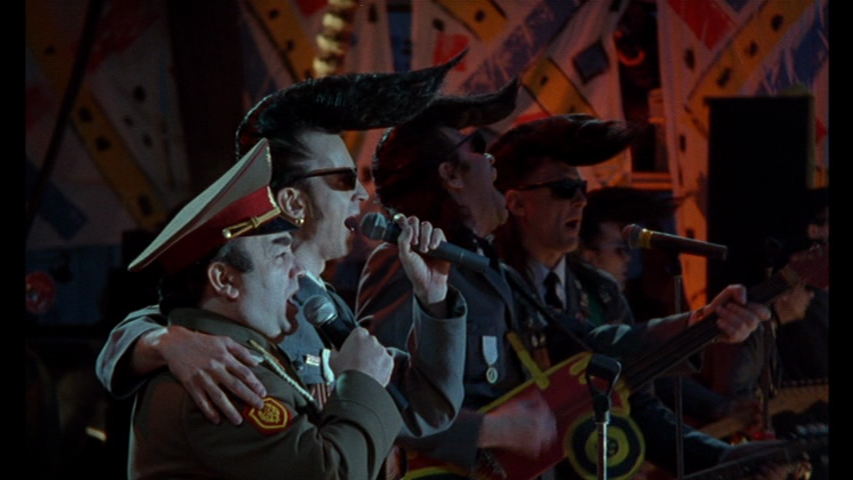
And if indeed the narrative well had run dry, that didn’t mean that Kaurismäki and the Leningrad Cowboys couldn’t still pull an ace out of their sleeve. The final film in the set is the one that’s already gotten the most play in my household. Total Balalaika Show documents an impressive concert performance staged in downtown Helsinki, in which the Cowboys are backed up by a full orchestra and massive men’s choir, the Alexandrov Red Army Chorus and Dance Ensemble. What a spectacular production – costumes and pageantry galore in a historic setting, the kind of event that one looks back on and wonders, “did that really happen?” And what a magnificent blend of traditional and contemporary songs, from the opening native land hymn, “Finlandia” to clever adaptations of Western classic rock staples like The Turtles’ “Happy Together,” ZZ Top’s “Give Me All Your Money” and Lynyrd Skynyrd’s “Sweet Home Alabama,” it’s a program designed to showcase the various acts doing what they do best, an eclectic blend of reverent bellowing, patriotic exhortation, whimsical in-jokes and affectionate transcultural dialogue. And these guys can really play too – all joking aside, the musicianship hits a consistently high standard throughout the entire set. Though not every number may be instantly familiar or in many viewers’ regular comfort zones, give the Leningrad Cowboys a chance to stretch the boundaries of what you consider entertainment. There’s not another band on earth quite like them.


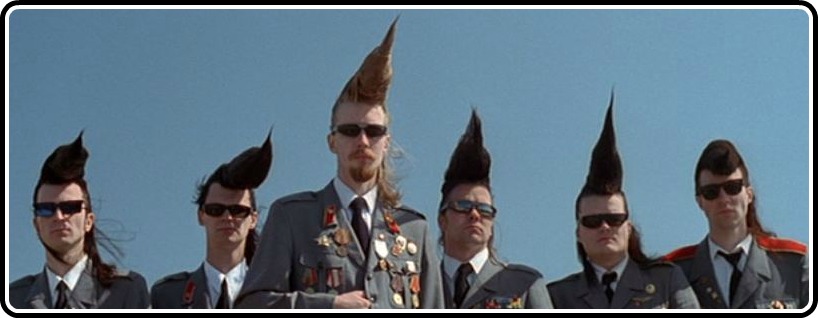

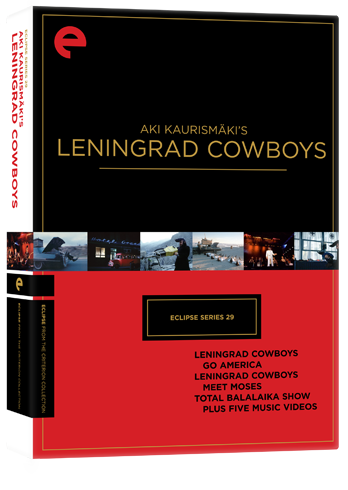
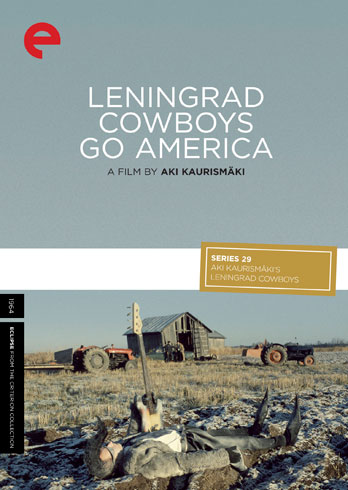
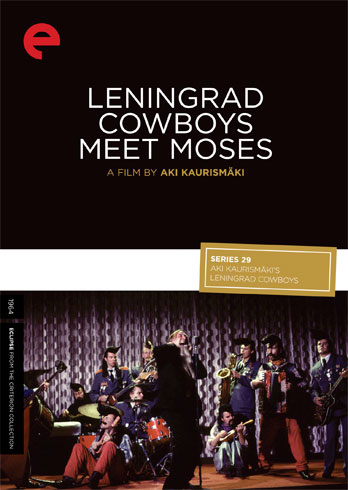
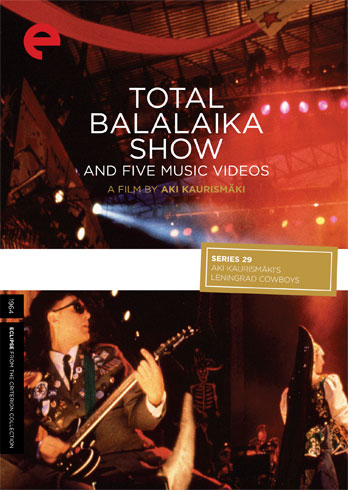

![Bergman Island (The Criterion Collection) [Blu-ray]](https://criterioncast.com/wp-content/uploads/2022/11/bergman-island-the-criterion-collection-blu-ray-400x496.jpg)
![This Is Not a Burial, It’s a Resurrection (The Criterion Collection) [Blu-ray]](https://criterioncast.com/wp-content/uploads/2022/11/this-is-not-a-burial-its-a-resurrection-the-criterion-collection-blu-ray-400x496.jpg)
![Lars von Trier's Europe Trilogy (The Criterion Collection) [The Element of Crime/Epidemic/Europa] [Blu-ray]](https://criterioncast.com/wp-content/uploads/2022/11/lars-von-triers-europe-trilogy-the-criterion-collection-the-element-of-400x496.jpg)
![Imitation of Life (The Criterion Collection) [Blu-ray]](https://criterioncast.com/wp-content/uploads/2022/11/imitation-of-life-the-criterion-collection-blu-ray-400x496.jpg)
![The Adventures of Baron Munchausen (The Criterion Collection) [4K UHD]](https://criterioncast.com/wp-content/uploads/2022/11/the-adventures-of-baron-munchausen-the-criterion-collection-4k-uhd-400x496.jpg)
![Cooley High [Criterion Collection] [Blu-ray] [1975]](https://criterioncast.com/wp-content/uploads/2022/11/cooley-high-criterion-collection-blu-ray-1975-400x496.jpg)
I have yet to dive in my copy of this set but I have seen several of the videos and Go America on the big screen. I have also eaten at the Leningrad Cowboys restaurant in Helsinki (which has since closed) and have a couple of their records… needless to say I am fan and I like that the whole set was written up in one shot to give readers a full picture of  the LC world….Â
Thanks Eric – I’ve written up a couple of “whole set” reviews over the past year – the First Films of Kurosawa and the Matarazzo Runaway Melodramas – even though I do intend to go back and review those films individually at some point. I’m jealous of your experience in Helsinki and sad to know that I will never have the privilege of dining at their fine establishment. I wonder if they’ll ever tour the USA? I’d drive a few hours to see ’em!
Good review of Cowboys – Thank You
And yes, they are deserving – as a ‘total package’ – of Greatness
Or, dare we say it – Art
.
Am a USA Baby Boomer, classically trained on several instruments, Degree in Humanities/Art/Film/Music, been in the ‘Biz’ most of my life, and if I’d known about, or seen, the Cowboys back in the 90s – shame on me for not remembering.
¿Unless I was merely suffering from PTSD? (smile)
Then a few years ago stumbled across their Sweet Home ‘Bama MTV clip on YouTube.
Sure ain’t forgot ’em since. (SMILE)
.
Now, with this Criterion Release, am in Leningrad Cowboy Heaven – Thank You
Criterion – you give validity to this talk of ‘Greatness’ – and saves visits to YouTube (yes, appreciate those efforts and intentions, but many of us are happy to pay for the quality that is Criterion).
.
Perhaps one day, years from now, someone will look back at the Cowboys – much in the same way we look back today on American Music from 100+ years ago which laid foundations for Jazz, Swing, Rock Roll – and know the Cowboys helped bring the Music and Art of our Global Village together into a type of New Fusion we can only guess about at this moment.
But – that’s just a guess.
Get back with me in 100 years and we’ll see how it goes.
Thanks Again
.
Thanks for the kind words and interesting thoughts, BC. Maybe after global warming has done its damage and Finland emerges as the seat of the next global empire, after the USA and China meet their inevitable demise, the Leningrad Cowboys will be seen centuries from now as the harbinger of a new cultural advance, the likes of which we can scarcely begin to imagine nowadays. Their hair and shoes definitely point the way forward, don’t they? :o)